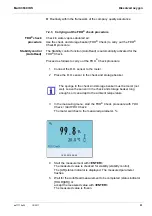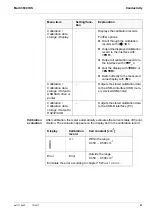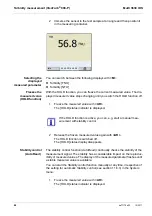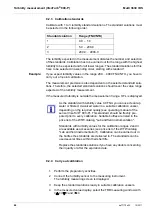
Multi 3630 IDS
Conductivity
ba77170e03
10/2017
59
8.3
Calibration
8.3.1 Why calibrate?
Aging slightly changes the cell constant, e.g. due to coatings. As a result, an
inexact measured value is displayed. The original characteristics of the cell can
often be restored by cleaning the cell. Calibration determines the current value
of the cell constant and stores this value in the meter.
Thus, you should calibrate at regular intervals.
8.3.2 When to calibrate?
After connecting a sensor
Routinely within the framework of the company quality assurance
When the cleaning interval has expired
8.3.3 Determining the cell constant (calibration in control standard)
You can determine the actual cell constant of the IDS conductivity sensor by
calibrating with the control standard in the following range:
0.450 ... 0.500 cm
-1
(e.g.
TetraCon 925
, nominal cell constant 0.475)
The cell constant is determined in the control standard, 0.01 mol/l KCl.
In the default condition, the calibrated cell constant of the IDS sensor is set to
0.475 cm
-1
(IDS conductivity sensor
TetraCon 925
).
Stability control
(AutoRead)
In calibration, the Stability control function (AutoRead) is automatically acti-
vated.
For this calibration procedure, the
Type
setting must be set to
cal
. Proceed as
follows to determine the cell constant:
Salinity (sea-
water)
Automatic
nLF
according to IOT
(International Oceanographic
Tables)
Sal
,
nLF
Test sample
Temperature compensation
Display indica-
tor
1
Connect an IDS conductivity sensor to the meter.
2
In the measured value display, select the conductivity parameter with
<M>
.
3
Start the calibration with
<CAL>
.
The cell constant that was calibrated last is displayed.
















































